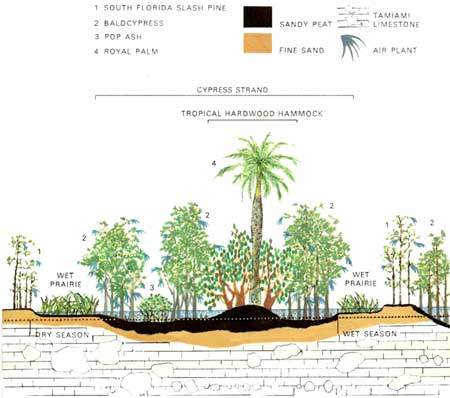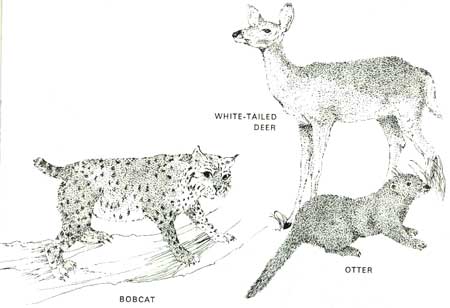|
EVERGLADES National Park |
 |
AMERICA'S SUBTROPICAL WONDERLAND
Big Cypress Swamp
To the west of the great fresh-water marsh called the everglades, lying almost entirely outside the park, is an ecosystem vitally linked to the park. Big Cypress Swamp is a vast, shallow basin that includes practically all of Collier County. It is commonly called "The Big Cypress"—not because of the size of its trees, but because of its extent. Most of the baldcypresses (which are not true cypresses) are small trees, growing in open to dense stands throughout the area. The swamp is watered by about 50 inches of annual rainfall, the runoff from which flows as a sheet and in sloughs south and west to meet the coastal strip of mangroves and low sand dunes.
Big Cypress is speckled with low limestone outcrops, cut with shallow sloughs 1 to 2 feet deep, and dotted with ponds and wet prairies. As in the everglades, fire and water maintain the character of the plantlife in this swampy realm of sunlight and shadow. Also as in the everglades, a difference of a few inches in elevation creates different communities. Tropical hardwood hammocks grow on rocky outcrops. In the depressions arise bayheads and clumps of pond apple, pop ash, and willow. The larger baldcypress trees grow in shallow sloughs, which are usually surrounded by prairies of sawgrass and maiden cane growing on slightly higher land. Although the several different plant communities resemble those in the glades, they support slightly different plants, because of the sandy soil (there being more quartz in the limestone under Big Cypress than in the park).
 BIG CYPRES SWAMP. 1) South Florida slash pine; 2) Baldcypress; 3) Pop ash; 4) Royal palm. (click on image for an enlargement in a new window) |
These baldcypresses, many measuring 3 to 6 feet in diameter, were heavily lumbered from 1930 to 1950. Today, few giant trees survive, but a sizable stand exists on the Norris Tract—so named for its conservation-minded donor—which forms the nucleus of Corkscrew Swamp Sanctuary. Here, protected by the National Audubon Society, are baldcypresses 130 feet tall; some have a girth of 25 feet! A boardwalk more than one-half mile long enables you to enjoy the beauty of this wild preserve without getting your feet wet.
Large stands of baldcypress, called "strands," support small communities such as ponds, prairies, and tropical hammocks. One such hammock is famous for the finest stand of royal palms remaining in south Florida. The largest cypress strand—the Fahkahatchee—extends some 23 miles north and south a few miles east of Naples.

Big Cypress Swamp is the home of wild turkey, bobcat, deer, and an occasional cougar. The fish-eating otter plays in its waterways. Most of the birds found in the everglades also are found in the trees and waterways of Big Cypress, because the swamp has an abundance of food. The area is so rich in wildlife and edible plants that the Seminole Indians formerly lived entirely off its products.
The eastern edge of the big swamp and its importance to Everglades National Park came to worldwide attention in 1969 when it was selected as the site for the proposed Miami International Jetport. According to plans, this was to be the biggest airport in the world, covering 39 square miles and handling 65 million passengers a year. Millions of persons were expected to make their home in and around the jetport. Such a threat to the national park, into which the waters of Big Cypress partly drain, provoked protest letters from all over the world. Most writers objected on the grounds that Everglades belongs to all, and that a jetport here would seal the doom of the park. Although it is still threatened by the bulldozer, Big Cypress Swamp will be remembered as the area that helped make "ecosystem" a household word.

|

|
| NPS History | History & Culture | National Park Service | Contact |
|
Last Modified: Sat, Nov 4 2006 10:00:00 pm PST |


